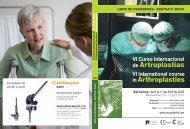cadera / hip - Active Congress.......
cadera / hip - Active Congress.......
cadera / hip - Active Congress.......
You also want an ePaper? Increase the reach of your titles
YUMPU automatically turns print PDFs into web optimized ePapers that Google loves.
JUEVES / THURSDAY<br />
190<br />
the patients at the time of surgery was 67<br />
years. Forty-four patients were male and<br />
39 female. Nine patients died at a mean<br />
of 6.6 years after the index arthroplasty. No<br />
patients were lost to follow-up. The mean<br />
duration of follow-up of the surviving patients<br />
was 10.0 years.<br />
Results:<br />
At the time of the most recent follow-up, 11<br />
medial compartment arthroplasties (10.3%)<br />
and both lateral compartment arthropalsties<br />
(100%) had been revised at a mean of 4.2<br />
years. Of the 13 revision procedures, three<br />
required use of revision components, and<br />
none required bone graft or augments. The<br />
mean Knee Society score for the surviving<br />
patients who had not had a revision improved<br />
from 100 points preoperatively to 172 points<br />
at the most recent evaluation. Kaplan-Meier<br />
survivors<strong>hip</strong> analysis revealed a probability<br />
of survival free of revision or radiographic<br />
loosening of 93% at 5 years, and 86% at<br />
10 years.<br />
Conclusions:<br />
The Miller-Galante unicompartmental knee<br />
arthroplasty can provide reliable pain relief<br />
and restoration of function in selected patients.<br />
Our experience has shown that the<br />
survivors<strong>hip</strong> of this implant approaches that<br />
of tricompartmental knee arthroplasty, and<br />
suggests that it may offer the advantage of<br />
ease of revision.<br />
UNICONDYLAR KNEE<br />
REPLACEMENT<br />
D. Dalury<br />
John Hopkins Hospital, Baltimore, USA<br />
UKAs have enjoyed a minor resurgence in<br />
popularity with increasing interest in miniincision<br />
surgery. Newer implants, improved<br />
instruments and better techniques have been<br />
credited with the procedures new popularity.<br />
While the classic UKA patient remains an<br />
elderly, thin, female with minimal deformity<br />
there has been more focus on utilization of the<br />
UKA as an alternative to HTO, and TKA in the<br />
younger patient. Early results with the newer<br />
designed implants will be reviewed.<br />
THE OXFORD KNEE<br />
K. R. Berend, MD and A. V.<br />
Lombardi, Jr, MD, FACS<br />
Joint Implant Surgeons, Inc.; The<br />
New Albany Surgical Hospital<br />
The Ohio State University;<br />
New Albany, Ohio, USA<br />
Summary: At two years, obesity, young age,<br />
and the presence of pre-operative anterior<br />
knee pain do not appear to negatively impact<br />
the outcome of Oxford UKA<br />
Some believe the so-called “Oxford Indications”<br />
for unicondylar arthroplasty are too<br />
liberal. Much of the debate in the United<br />
States centers on the performance of UKA<br />
in severely obese patients, young patients,<br />
and patients with anterior knee pain or patellofemoral<br />
DJD. Since approval of the Oxford<br />
UKA in 2004 we have performed over 300<br />
cases using the Oxford criteria. The average<br />
age of the patients was 62.4 years (range:<br />
41-87; SD: 12) with 54% of patients under 60<br />
years old. The average weight of the patients<br />
is greater than 90 kg (range: 51-142; SD: 17<br />
kg). In 64% the patient weight was greater<br />
than 80 kg. The average BMI of the patients<br />
was 31.6 (range: 21-48; SD: 6). 61% were<br />
performed in patients considered obese with<br />
a BMI greater than 30. In 25% of cases the<br />
patients were categorized as morbidly obese<br />
with BMI greater than 35. More than 40% of<br />
UKA were performed in patients with a BMI<br />
greater than 32, a category considered at risk<br />
for failure secondary to obesity. 6% of patients





